How Long Does Steak Last in the Fridge
Raw steak will last 3-5 days in your fridge when stored properly at or below 40°F (4°C). You'll get the best results by wrapping your steak tightly in plastic wrap or aluminum foil, then placing it in an airtight container on the bottom shelf where it's coldest. For maximum freshness, vacuum-sealed packages can extend storage up to 5 days, while meat left in its original store packaging should be used within 1-2 days. Watch for signs of spoilage like gray coloring, slimy texture, or strong odors. If you've cooked your steak, you've got 3-4 days to enjoy it. Proper storage techniques can help you maximize your steak's shelf life and maintain its quality.
This post may contain affiliate links. If you make a purchase through these links, I may earn a commission at no additional cost to you. Additionally, portions of this post may be generated using artificial intelligence (AI) technology. While we strive for accuracy, please be aware that AI-generated content may not always be perfect and should be fact-checked when necessary.
The Spatula Scoops
- Raw steak lasts 3-5 days in the fridge when stored at or below 40°F and properly wrapped in airtight packaging.
- Fresh steak in original store packaging only lasts 1-2 days in the refrigerator before quality begins to decline.
- Vacuum-sealed raw steak maintains superior quality and can last up to 5 days when refrigerated properly.
- Cooked steak remains safe to eat for 3-4 days when stored in an airtight container in the refrigerator.
- Storage location matters – keep steak on the bottom shelf at the back of the fridge for maximum freshness.
Raw Steak Storage Guidelines
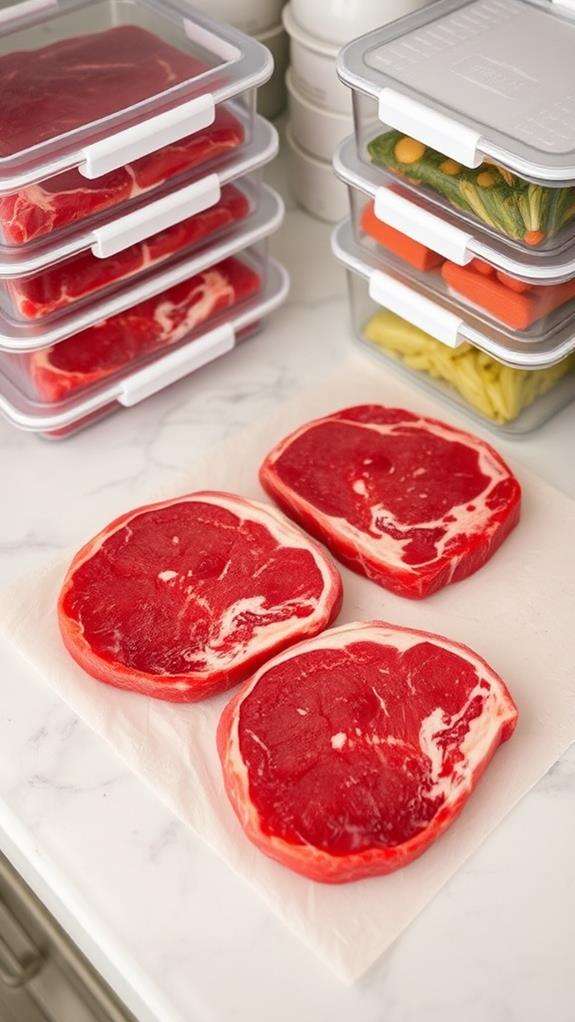
Three key factors determine how long raw steak stays fresh in your fridge: proper storage temperature, packaging, and initial meat quality. You'll need to maintain a consistent temperature between 34-40°F (1-4°C) in your refrigerator to maximize freshness and prevent bacterial growth.
When it comes to packaging, you've got several options to protect your raw steak. If you're keeping the meat in its original store packaging, you can store it for 1-2 days. For longer storage, you'll want to wrap the steak tightly in plastic wrap or aluminum foil, or place it in an airtight container. This prevents oxidation and limits exposure to bacteria.
The quality of your steak when purchased plays an essential role in its storage life. You'll want to check for a fresh, red color and firm texture before buying. If you notice any grey areas or slimy texture, don't purchase the meat. Once you've brought your steak home, store it in the coldest part of your fridge, typically the bottom shelf. This location prevents any meat juices from potentially dripping onto other foods and maintains ideal temperature.
Signs of Spoiled Steak
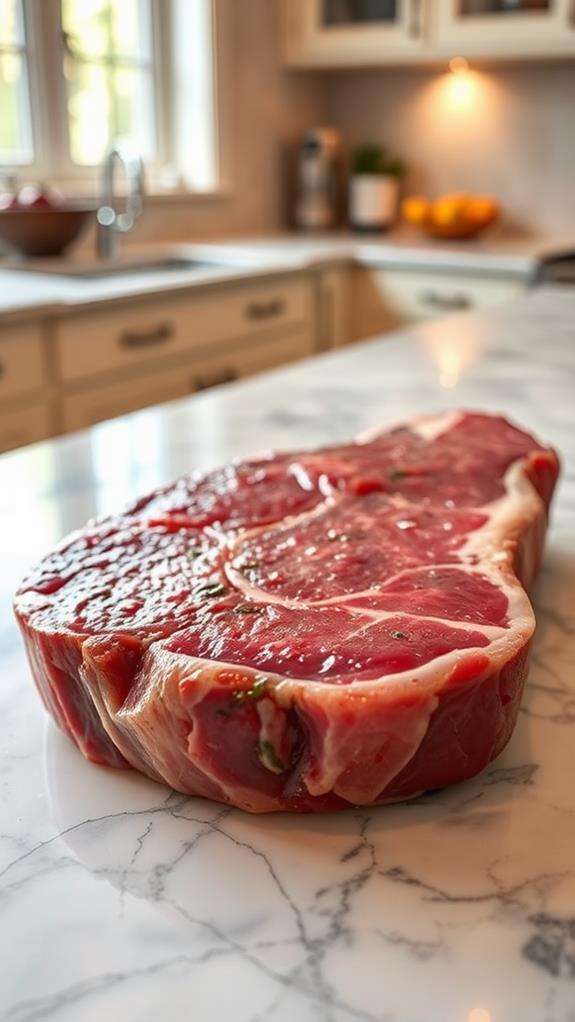
When checking if your steak has spoiled, you'll need to watch for three key warning signs that make it unsafe to eat. The first and most obvious indicator is any dramatic color change from the steak's original red to brown, gray, or green, especially if accompanied by unusual dark spots or discoloration. Most importantly, you'll want to check for a slimy or sticky texture on the surface and any strong, unpleasant odors that seem off, particularly sour or rancid smells that hit you immediately upon opening the package.
Color Changes and Appearance
Color changes offer immediate visual cues that your steak may be spoiling. Fresh steak typically displays a vibrant red or pinkish-red color due to the presence of oxymyoglobin, a protein that binds with oxygen. When your steak begins to turn, you'll notice distinct color transformations that signal potential spoilage.
Watch for these specific color indicators:
- Brown or gray patches spreading across the meat's surface, indicating oxidation and the breakdown of muscle tissue
- Dark green or black spots, which often suggest bacterial growth and advanced decomposition
- Iridescent or rainbow-like sheen on the surface, which isn't necessarily spoilage but can indicate that the meat's structure is breaking down
You'll also want to examine the steak's overall appearance. A fresh cut should look relatively dry and firm, but spoiled steak often develops a slimy or tacky film on its surface. If you notice any unusual shiny patches or if the meat appears excessively wet, it's likely that bacteria have begun colonizing the surface. Trust your instincts – if the steak's appearance seems off in any way, it's better to err on the side of caution.
Strong Unpleasant Odors
Your nose serves as one of the most reliable tools for detecting spoiled steak. When fresh, raw steak should have a mild, meaty smell that's barely noticeable. If you're detecting strong, unpleasant odors, your steak has likely begun to spoil. You'll want to watch out for several distinct smells that indicate spoilage.
A sour or tangy aroma is one of the first warning signs you'll notice. If your steak gives off a rancid, ammonia-like smell, it's definitely time to discard it. You might also detect what's often described as a "cheese-like" odor, which occurs when bacteria begin breaking down the meat's proteins. Don't ignore these warning signs, as they're clear indicators of bacterial growth and decomposition.
Sometimes, you'll notice that the smell becomes stronger when you've just unwrapped the meat from its packaging. If you're unsure about the smell, try placing the steak on a clean plate and letting it sit for a minute. Fresh steak won't develop an increasingly pungent odor, while spoiled meat will continue to emit strong, offensive smells that become more pronounced over time.
Slimy or Sticky Texture
Beyond smell, texture changes offer clear evidence of spoiled steak. When you're examining your refrigerated steak, the texture should feel firm and slightly cool to the touch. If you notice any abnormal changes in the meat's surface, it's likely that bacterial growth has begun to compromise its safety.
A fresh steak's surface should be relatively dry and maintain its original color and firmness. When spoilage occurs, you'll notice these distinctive textural changes:
- The meat's surface develops a glossy, slick film that feels unusually wet or sticky when you touch it with your finger
- The texture becomes tacky or mucus-like, creating string-like formations when you lift your finger away
- Areas of the steak feel unusually soft or mushy, rather than maintaining the characteristic firmness of fresh meat
Don't attempt to "save" a steak that displays these texture changes by washing or trimming it. The slimy or sticky coating indicates bacterial proliferation that's already penetrated the meat's surface. At this point, the safest course of action is to discard the steak immediately to prevent potential foodborne illness.
Proper Refrigeration Techniques
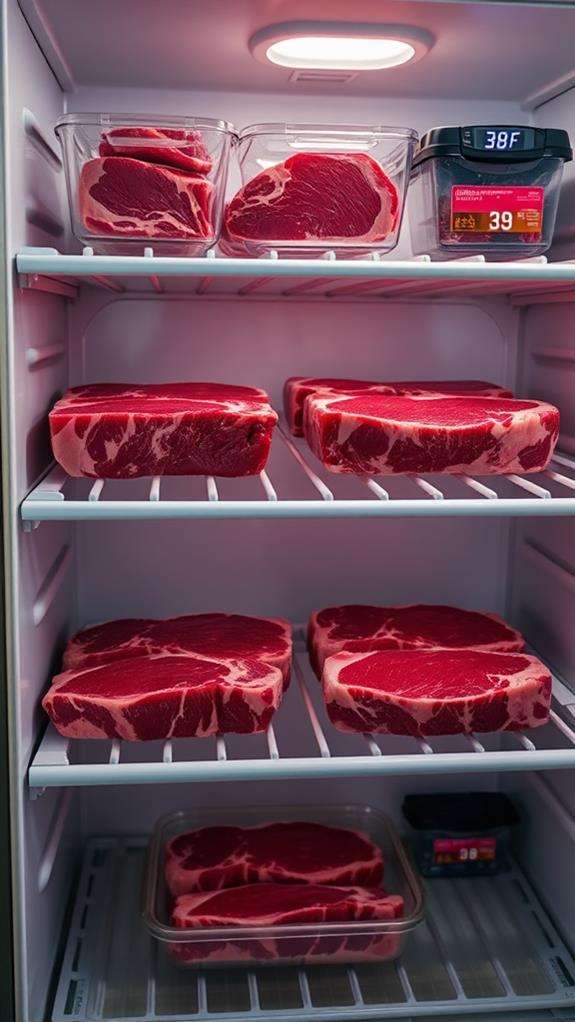
Storing steak correctly in your refrigerator can make the difference between fresh, flavorful meat and a spoiled dinner. To maximize your steak's shelf life, you'll need to follow several key storage principles that professional chefs rely on.
Keep your refrigerator temperature at or below 40°F (4°C), and store your steak in the coldest part, typically the back of the bottom shelf. Don't leave the meat in its store packaging; instead, wrap it tightly in plastic wrap or aluminum foil, then place it in an airtight container or freezer bag to prevent cross-contamination and oxidation. If you're planning to use the steak within two days, you can simply wrap it in butcher paper.
Make sure you're organizing your refrigerator properly, keeping raw meat separate from other foods. You'll want to place a plate or tray under the wrapped steak to catch any potential drips. If you've got multiple pieces of steak, don't stack them on top of each other, as this can lead to uneven cooling and potential bacterial growth. Label each package with the purchase date so you can track how long it's been stored.
Extending Steak Shelf Life
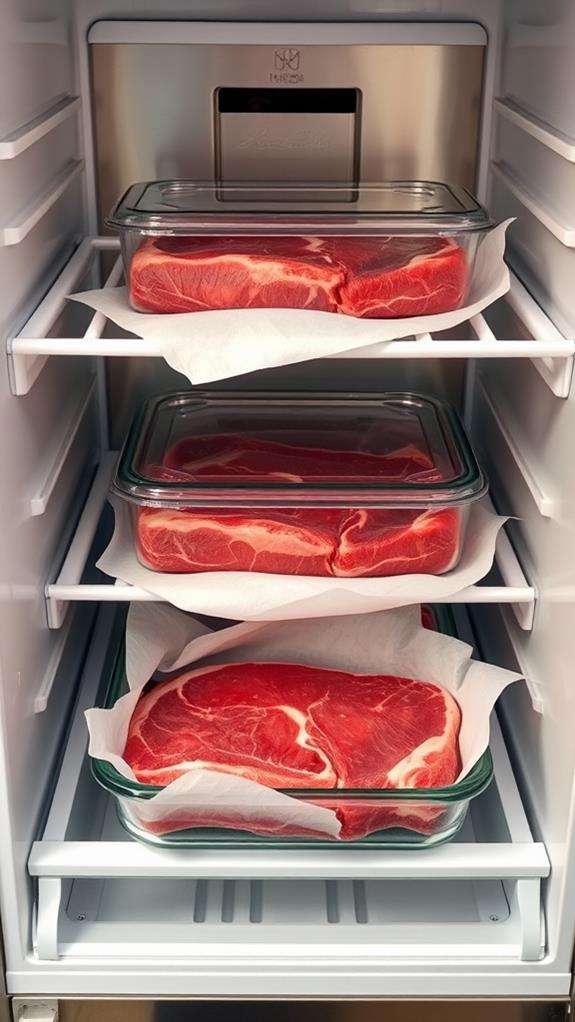
While following proper storage techniques forms the foundation, several additional strategies can greatly extend your steak's refrigerator life. You'll want to focus on minimizing bacterial growth and maintaining ideal moisture levels to preserve your meat's quality. Understanding these methods can help you save money and reduce food waste.
- Vacuum seal your steak using a food-grade sealing system, removing all air that could lead to oxidation and bacterial growth. If you don't have a vacuum sealer, wrap the steak tightly in plastic wrap, then add a layer of aluminum foil.
- Place your wrapped steak in the coldest part of your refrigerator, typically at the back of the bottom shelf where temperatures remain most consistent, maintaining 34-38°F (1-3°C).
- Consider using food-grade oxygen absorbers or moisture-control packets when storing your steak, especially for longer periods. These help prevent both bacterial growth and freezer burn.
You'll also want to keep your steak away from other raw foods and strong-smelling items, as meat can absorb odors even through packaging. If you're not planning to use the steak within five days, it's better to freeze it immediately.
Cooked Steak Storage Times
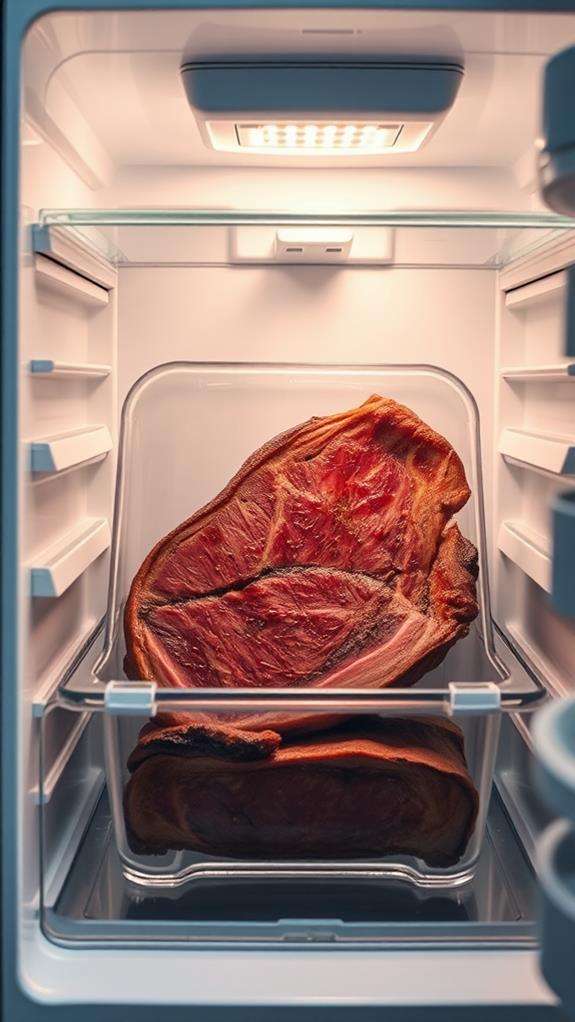
Cooked steak remains safe to eat for 3-4 days when stored properly in your refrigerator. You'll need to store it in airtight containers or wrap it tightly in aluminum foil or plastic wrap to maintain its quality and prevent bacterial growth. The temperature in your fridge should stay at or below 40°F (4°C) to guarantee food safety.
| Storage Method | Maximum Time | Quality Rating |
|---|---|---|
| Airtight Container | 4 days | Excellent |
| Aluminum Foil | 3-4 days | Very Good |
| Plastic Wrap | 3 days | Good |
| Vacuum Sealed | 5 days | Superior |
| Original Package | 2 days | Fair |
You'll notice changes in your cooked steak's texture and flavor as time passes. After the first day, it might become slightly drier, but it's still perfectly safe to eat. If you're planning to store it longer than 4 days, you should transfer your cooked steak to the freezer, where it'll maintain its quality for up to 3 months. Always check for signs of spoilage before consuming, including off-odors, slimy texture, or unusual coloring.
Safe Handling and Packaging
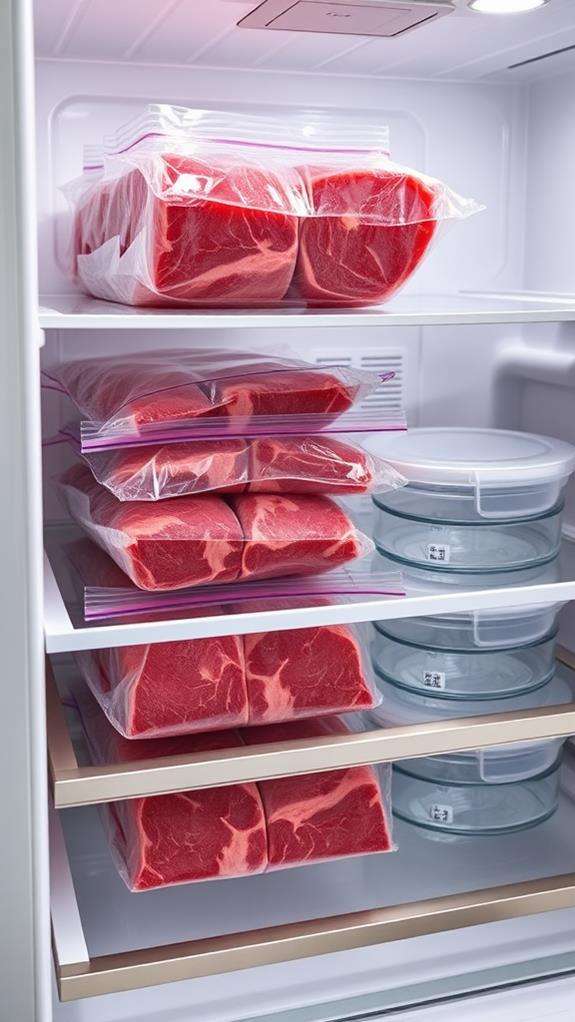
Proper handling and packaging make all the difference in keeping your steak fresh beyond its initial storage. You'll need to take specific precautions when handling raw meat to prevent cross-contamination and maintain peak freshness.
When you're storing your steak, make sure you're following these critical steps:
- Wrap your steak tightly in plastic wrap or butcher paper, then place it in a freezer-quality zip-top bag to create a double barrier against air exposure and prevent freezer burn.
- Remove as much air as possible from the packaging before sealing – you can use the water displacement method or a vacuum sealer for best results.
- Label each package with the date of purchase and type of cut using a permanent marker, which helps you track freshness and rotation.
Don't reuse packaging materials that have come in contact with raw meat. If you're planning to store your steak for more than two days, place it in the coldest part of your refrigerator, typically the back bottom shelf. This location maintains the most consistent temperature and prevents any potential drips from contaminating other foods.
Frequently Asked Questions
Can I Refreeze Steak That Has Been Thawed in the Refrigerator?
Yes, you can safely refreeze steak that's been thawed in the refrigerator. When you've thawed meat properly in the fridge, keeping it at a consistent temperature below 40°F, it's safe to return it to the freezer. You'll want to refreeze it within 3-5 days of thawing. Keep in mind that while it's safe, each freeze-thaw cycle can affect the meat's texture and quality, potentially making it slightly less tender.
Does Marinating Steak Make It Last Longer or Shorter in the Fridge?
Marinating your steak won't extend its shelf life; in fact, it might slightly reduce it. When you're marinating meat, you're adding moisture and ingredients that can encourage bacterial growth. You'll want to keep marinated steak in your fridge for no more than 5 days, and it's best to use it within 2-3 days. If you've got specific marinade plans, it's smart to buy your steak fresh right before you intend to use it.
Should I Keep Steaks in Their Original Store Packaging?
Like a delicate flower needs the right vase, your steak needs proper storage. You shouldn't keep steaks in their original store packaging, as these materials aren't designed for extended storage. Instead, you'll want to rewrap your steaks in plastic wrap, foil, or better yet, vacuum-seal them. This prevents freezer burn and bacterial growth. If you're storing for more than a day, double-wrap them or place them in an airtight container.
Can I Store Different Types of Raw Meat Together?
You shouldn't store different types of raw meat together, as this increases the risk of cross-contamination. While it's tempting to group all meats in one area, different meats can harbor distinct bacteria and require varying storage temperatures. Instead, you'll want to keep them in separate, sealed containers or bags, and place them on different shelves in your fridge, with poultry at the bottom to prevent drips onto other foods.
Does Vacuum-Sealed Steak Need to Be Refrigerated Immediately After Purchase?
Yes, you'll need to refrigerate vacuum-sealed steak right after purchase, even though the packaging offers better protection than regular wrapping. While vacuum-sealing extends shelf life by reducing exposure to air and bacteria, it doesn't eliminate the need for cold storage. If you won't be home immediately after shopping, you should use a cooler or insulated bag to keep your vacuum-sealed steak at a safe temperature below 40°F (4°C).





